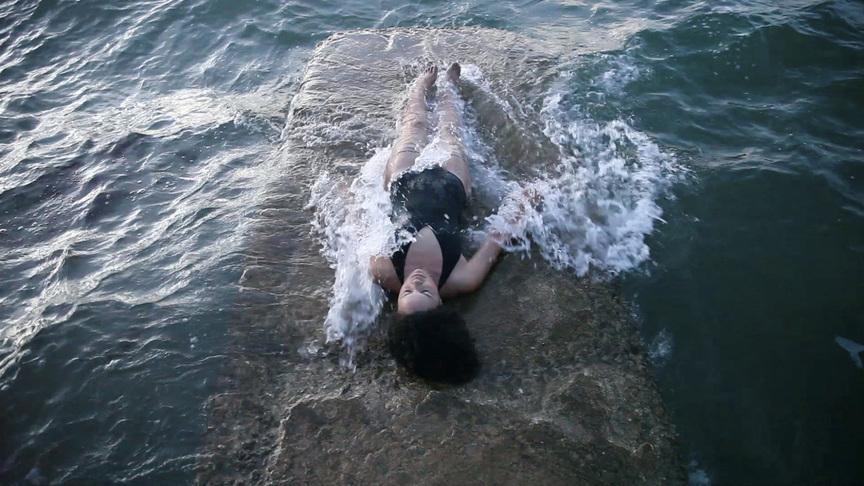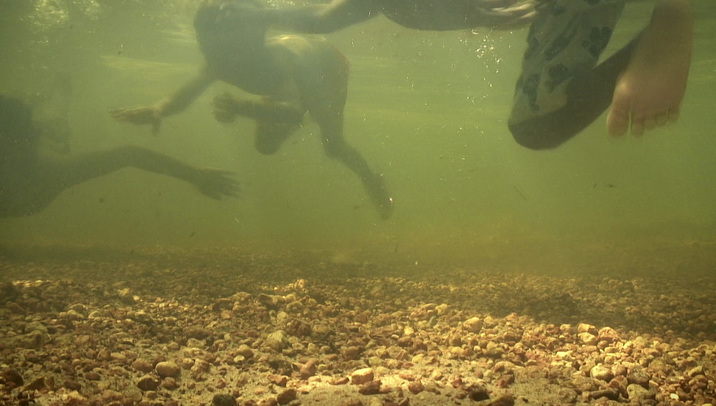-
From Current Issue
-
- Editor’s Letter Fire in the Heart
- Reviews I Gusti Ayu Kadek Murniasih
- Reviews 11th Seoul Mediacity Biennale: “One Escape at a Time”
- Dispatch Networked China
- One on One Monira Al Qadiri on Yukio Mishima
- Essays The rise of independent art spaces in pandemic-era Shanghai
- Features Tuan Andrew Nguyen
- Table of Contents
- Web Exclusives
- Archive
- Subscribe

R
E
V N
E
X
T
Installation view of OLAFUR ELIASSON’s Riverbed, 2014, site-specific installation, dimensions variable, at Queensland Art Gallery | Gallery of Modern Art (QAGOMA), Brisbane, 2019–20. Courtesy the artist; neugerriemschneider, Berlin; Tanya Bonakdar Gallery, New York / Los Angeles.
“Water”: A Poetic Journey Toward an Ecological Future
Concerns for water’s overabundance and scarcity are especially pressing in Australia. Bordered by the ocean yet riddled with drought and flood, in recent months the continent desperately needed rain to quell a devastating bushfire season that blanketed cities in smoke; including Brisbane, home to Queensland Art Gallery | Gallery of Modern Art (QAGOMA). These extremities spoke to the timeliness of the institution’s “Water” exhibition, which focused on the natural environment; its splendor, fragility, and ability to give life or take it away. With a mix of large-scale, immersive installations and intimate works by Australian and international artists, this group exhibition invoked the magnetism of water while underscoring the urgency of the climate crisis.
“Water” offered atmospheric and rhythmic shifts over five independent yet interconnected exhibition chapters, touching upon key issues characterizing our relationship with this resource. Gallery spaces darkened or lightened, expanded or contracted, and felt heavier or airborne—much like the fluidity of water itself—evoking a natural world in flux.
In her video Holding On (2015), Angela Tiatia is at times gently rocked, and at other moments almost thrown off a concrete ledge by Pacific tidal flows, highlighting the vulnerability of nations in the region to climbing sea levels. The rise and fall of waves washing over her outstretched body mirror the undulating rings of William Forsythe’s site-specific installation The Fact of Matter (2009), around the corner. Participants were invited to lift their bodies and cross the room via a network of gymnastic rings suspended at varying heights. Initially interrogating ideas of choreography and the body in motion, the work was recontextualized here, prompting viewers to consider new methods for collectively navigating environmental challenges. Yet it was deceptively difficult, as many strained their way across or gave up partway. Although somewhat playful and optimistic, the work reflected the difficulties of overcoming environmental challenges, including reticence from countries such as Australia—repeatedly criticized by the United Nations for its climate policy and failure to adequately decrease greenhouse gas emissions.
Taking over an entire gallery nearby, viewers could walk upon the pebbled slopes of Olafur Eliasson’s rocky installation Riverbed (2014), and interact with the man-made stream. In this space Eliasson questions how participants engage with this seemingly post-apocalyptic barren landscape and others around us—is this a site for play, discovery, observation, contemplation, or despair?
Mata Aho Collective’s monumental Kiko Moana (2017) was another significant moment, exploring the grounding qualities of water as it transforms and sustains life. In Māori, kiko refers to base or body, while moana refers to the ocean. Comprising 60 blue tarpaulins geometrically woven into one using traditional Māori sewing techniques, the work draws upon mana wāhine (women’s empowerment) and tales of taniwha (Māori water spirits). Partially suspended from the ceiling, the 11-meter creation rises and envelopes viewers like a tidal wave, holding and carrying them over its peak.
In the final chapter, the film Mayaŋ (2011) by Yolngu artist Ruby Djikarra Alderton features energetic young swimmers in a glowing amber creek as the artist recounts personal and familial memories of a creek now under threat of being completely destroyed in north-east Arnhem Land. In an intimate, softly lit room, Mayaŋ contemplates the impact of changing waterscapes upon communities for whom these sites nourish culture, growth, and knowledge-sharing. This piece resonates with Megan Cope’s recreation of an architectural shell midden near the entrance, RE FORMATION (Noogoon/St Helena Island) (2019). Made with cast-concrete oyster shells and sand-like black copper slag, the sculptural installation references the colonial lime-burning which harmed coastal shellfish reefs, once an important food source for local communities. Coming full circle, the two works accentuate the rich history of coexistence between Australia’s First People and the ocean.
While acknowledging the importance of this life source in Australia, “Water” situated local perspectives in an international context to elicit this element’s global significance and capacity to unite. Although some moments were more effective than others, the exhibition was a timely call to action, provoking critical conversations that urge us to realize a collective future on this planet that is harmonious with nature.
“Water” was scheduled to be on view at the Queensland Art Gallery | Gallery of Modern Art, Brisbane, until April 26, 2020. Please check the exhibition web page for up-to-date information in light of Covid-19.
To read more of ArtAsiaPacific’s articles, visit our Digital Library.











